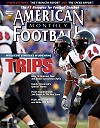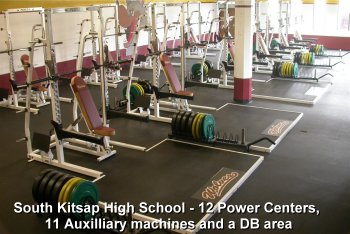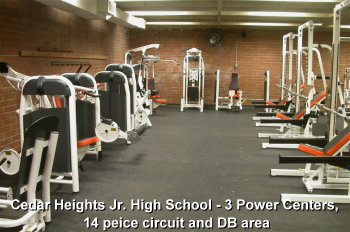AMERICAN FOOTBALL MONTHLY THE #1 RESOURCE FOR FOOTBALL COACHES
Article CategoriesAFM Magazine
|
Head Start - Strength Programs Are Now Starting in Junior HighsSpecial Advertising Feature© More from this issue A growing national trend was illustrated this year in South Kitsap School District near Seattle: the installation of strength and fitness equipment in the district’s three junior high schools. It’s a trend that’s gaining momentum around the country, as football coaches, along with physical education administrators, recognize the benefits of having students exposed to strength and conditioning training at an earlier age.  South Kitsap High Head Football Coach D.J. Sigurdson
realized he had an opportunity to expand strength training to the
district’s junior highs while he was building a case for new equipment
at the high school. The school has a proud football tradition including
a state championship, but the program’s weight room was sub-standard.
Sigurdson’s ambition, like many progressive high school coaches, was to
create a strength program that resembled those of small universities.
He knew that meant some big changes. South Kitsap High Head Football Coach D.J. Sigurdson
realized he had an opportunity to expand strength training to the
district’s junior highs while he was building a case for new equipment
at the high school. The school has a proud football tradition including
a state championship, but the program’s weight room was sub-standard.
Sigurdson’s ambition, like many progressive high school coaches, was to
create a strength program that resembled those of small universities.
He knew that meant some big changes.“We did the best we could with the strength equipment that had been generously provided,” said Sigurdson, “but our kids were basically training on home-made equipment.” With the help of his Assistant Superintendent and Director of Secondary Curriculum, Sigurdson set out to convince the district that new strength facilities were necessary at the high school and that junior high facilities would enhance the phys ed program. “We talked about other curricular areas having adoption cycles for textbooks and classroom materials. High school PE had not had an adoption in the last 14 years and there had not been a district-wide adoption for decades.” The school district acknowledged the need Sigurdson had highlighted and got behind the project, which entailed much more than just buying a few power racks. “We wanted a coordinated PE strength and fitness program for the whole district that aligned with our state standards,” according to Sigurdson. “Of course this would also help our younger athletes prepare for the training they will take part in as part of South Kitsap football. We don’t want our kids maxing out consistently as 7th or 8th graders, but we want them familiar with core movements by the time they hit our program. A kid who has never really lifted properly before may spend most of a sophomore year learning technique before we can begin to really improve his strength. Now that process can occur at the junior high level.” The funding provided by the district was the key to the project, but that was only the beginning of the process. “We knew we wanted quality equipment and narrowed it down to a handful of top brands,” recalled Sigurdson. “We also needed to ensure that the equipment we chose had the best features and warranty and that each room had the most functional layout.” In the final analysis, one equipment company rose above the rest – Forza Strength Systems. “Throughout the selection process, Forza stood out as a vendor that would provide extra effort, strong personal service and sound ideas. I knew basically what we wanted, but Forza helped me decipher equipment choices and design layouts for each room. They made a complicated process easy. Ultimately, the committee’s decision to go with Forza was a no-brainer,” said Sigurdson. 
The committee chose Forza equipment not only for the heavy-duty construction that could handle consistent use by the football team, but also for features that Sigurdson knew would make junior high phys ed instructors happy. “From an athletics standpoint, we wanted the 7-gauge tube on our power racks, the bench that locks in to the rack, the quick adjustment on our bar catchers, and the custom logos on our platforms. But from a PE standpoint we also were looking for machines with easy adjustments, all the bells and whistles, and a modern look. Forza equipment fit the bill for the specific needs of our high school and junior high facilities.” Sigurdson set out clear objectives for what the new rooms would mean for students. “During the school year we have only 50 minutes per session, so we need efficiency. That’s why we chose to base our room around the Power Center concept. I can have 48 kids on squat, or each group of four players on a different lift if I choose. I have flexibility and our wasted time has gone way down.” But as all football coaches know, a system provides the framework but execution makes the system work. Sigurdson’s answer to what it takes to execute in his new system? “It’s energy! When my kids step on the Wolves logo on these lifting platforms, they feel special, and it shows in their effort.” The result of Sigurdson’s collaboration with Forza is a state-of-the-art weight room in South Kitsap High School and three ground-breaking strength and conditioning facilities in the district’s junior high schools. With 12 Forza Power Centers, 11 auxiliary machines, and a dumbbell area, the high school’s strength room is more free-weight focused than the junior highs with their three power centers, 14-piece machine circuits and dumbbell areas each. “A kid will be lifting on the same Forza power rack he used the last year at his junior high. It will be familiar to him,” said Sigurdson. With a smile he adds, “And if he was using 60 pounds on the leg curl last year, he better be using 70 now, because it’s exactly the same machine!” It’s this coordinated push toward having the best-prepared athletes that D.J. Sigurdson hopes will be another piece of the puzzle in keeping his Wolves among the state’s elite. |
|
| HOME |
MAGAZINE |
SUBSCRIBE | ONLINE COLUMNISTS | COACHING VIDEOS |
Copyright 2025, AmericanFootballMonthly.com
All Rights Reserved




